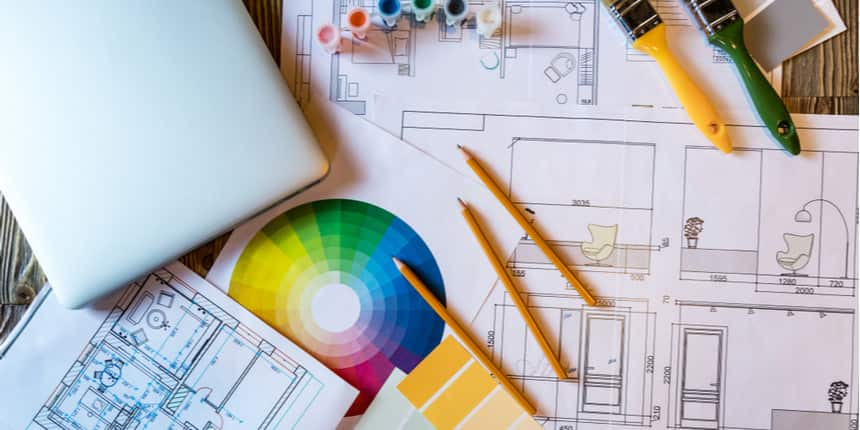Apeejay Institute of Design, Delhi B.Design Admissions 2025
100% Placement Assistance. Ranked among top 5 Design Institutions in the Country
BID full form is Bachelor of Interior Design, it is a four-year undergraduate degree programme that provides comprehensive knowledge of interior design. Bachelor of Interior Design course curriculum includes subjects such as spatial design, aesthetics, functionality, and safety aspects. The course curriculum is spread across eight semesters, it includes both practical and theoretical sessions. Students who have successfully completed their 10+2 from a recognised institute in India can opt to pursue this course.
Announcement: Register for India's Biggest Education Expo
Latest: CUET 2024 Companion | Liberal Arts Complete Guide
Don't Miss: Top B.I.D Colleges in India | UCEED | NID DAT | NIFT

Interior Design is involved with choosing the products, colours, materials, styles and fabrics to decorate the rooms, houses, offices and other establishments. Interior Designers are involved with building interiors that are both visually appealing and functional.
A Bachelor's in Interior Design provides knowledge on various aspects of Interior Design, such as colour theory, architectural drafting, furniture design, lighting, and sustainable design practices. A bachelor's degree in interior design provides the students with knowledge of design software and participation in hands-on projects, real-world simulations, and internships to apply theoretical knowledge in practical settings.
The full form of BID is a Bachelor of Interior Design, which is an undergraduate degree programme, that emphasises the technical, artistic and aesthetic aspects of interior design. In the Bachelor in Interior Design course, students learn how to conceptualise and create functional, aesthetically pleasing, and culturally relevant interior decoration for residential and commercial environments.
| Particulars | Values |
|---|---|
Course Type | Degree |
BID Course Level | Undergraduate |
BID Course Duration | 4 years |
BID Eligibility Criteria | 10+2 from a recognised board with 50 per cent aggregate score |
BID Admission Process | Entrance exam/Merit-score |
BID Course Type | Semester Wise |
BID Entrance Examination | AIEED, UCEED, NID DAT |
BID Average Fees | Rs. 20,000 to Rs. 5 Lakhs |
BID Career Opportunities | Interior Designer, Textile Designer, Exhibition Organiser, Space Planner, Event Designer, Retail Designer, Consultant Stylist, Window Display Designer, Kitchen Designer |
BID Average Salary | Rs. 8 LPA |
Bachelor of Interior Designing course fees vary depending on institution. Private universities may charge a high Bachelor of Interior Designing course fees for admissions, however, government colleges generally charge less Bachelor of Interior Designing course fees. The Bachelor of Interior Designing course fees will range from Rs. 20,000 to Rs. 5 LPA.
From a job perspective, the bachelor of interior design is of immense importance and because of the growing need for an interior designer. It has recently been estimated that jobs in the interior construction industry are expected to increase globally by at least 13 per cent over the next decade. In India, the domestic construction industry is predicted to contribute more than 10 billion dollars in annual revenue. For those who have successfully built a strong reputation and track record, it is a method that can have unlimited potential in terms of career fulfilment and financial rewards.
Mentioned below are the minimum eligibility criteria that interested candidates need to fulfil, to be eligible to apply for admission to the programme.
| Eligibility Parameters | Details |
|---|---|
Educational Qualification | 10+2 from a recognised institute in India |
Minimum aggregate score | 50-60 per cent (5-10 per cent relaxation for candidates belonging to the reserved categories) |
Entrance Examination | UCEED and NID DAT are the popular examinations |
Students can pursue a Bachelor of Interior Designing degree after completion of 10+2 from a recognised board in India. Aspirants need to appear for an aptitude test which is conducted by various universities and colleges. Admission takes place through one of the following modes:
Entrance Exams: Admission takes place through entrance exams like NID DAT, CEED, AIEED, NATA. Scores in these entrance exams and 10+2 percentage are considered for admission to the Bachelor of Interior Designing degree programme. Admission to the course in most institutes is based on the candidate’s performance in a relevant entrance examination and the following round of counselling.
GD/ PI Round: The counselling round comprises two rounds i.e., Group Discussion and Personal Interview, wherein the candidate’s general aptitude for the course is examined. However, there are some institutes and universities that provide admission solely on the basis of the student’s performance in the qualifying examination.
The minimum grade required for admission to a university is the B.I.D (Bachelor of Interior Design) cutoff. Each course and university has its own set of requirements. The difficulty of the entrance exam, the number of candidates, prior year cutoff trends, and the popularity of the course all influence cutoffs. Cutoffs for the following batches have been published by universities that provide B.I.D (Bachelor of Interior Design) degrees.
A number of Indian institutions offer a B.I.D. programme. Academic achievements and admission exam scores are used to determine admission to the B.I.D programme. Here is a list of the best B.I.D. institutes in India's major cities.
The Bachelor of Interior Design course curriculum differs depending on various factors. In India, various private and government colleges offer this course. In the table below, we have mentioned the Bachelor of Interior Design syllabus of BID.
In the first year syllabus of Bachelor of Interior Design, some of the subjects included are Fundamentals of Structure, Research Strategies and Design Process, Analytical Drawing, Material Exposure, and Basic Photography.
| Semester 1 | Semester 2 |
|---|---|
| Fundamentals of Structure 1 | Fundamentals of Structure 2 |
| Theory of Design | Research Strategies Design Process |
| Freehand Drawing and Geometric Construction | Analytical Drawing |
| Communication Skills | Humanities, Art, Appreciation and Appraisal |
| Material Exposure | Basic Photography |
In the second year syllabus of the Bachelor of Interior Design students study subjects such as History of Crafts and Interior Design, Building Services, Interior Materials, Technical Drawings and Computer Applications. In the table below, we have discussed the 2nd year syllabus of Bachelor of Interior Design (BID).
| Semester 3 | Semester 4 |
|---|---|
| History of Crafts and Interior Design 1 | Building Services 1 |
| Interior Materials 1 | Interior Materials 2 |
| Anthropometry and Ergonomics | Elective: Poetry and Literature OR Elective: Journalism |
| Technical Drawings and Computer Applications | Advance Computer Application |
| Interior Construction 1 | Interior Construction 2 |
In the third year of Bachelor of Interior Design, students will study concepts related to Interior Construction, Arts and Crafts, Interior Construction, and Materials and Processes.
| Semester 5 | Semester 6 |
|---|---|
| Building Services 2 | Building Services 3 |
| Interior Materials 3 | Cost and Estimation |
| Materials and Processes 1 | Arts and Crafts |
Elective: Dance and Music OR Elective: Theatre and Filmmaking | Elective: Human Interaction OR Elective: Marketing |
| Interior Construction 3 | Interior Construction 4 |
| Interior Design 3 | Interior Design 4 |
A bachelor of interior design course is one of the most sought-after courses among students who want to build a career in an artistic field. Students can opt for various specialisations in degrees in interior designing. In the table below, we have mentioned some of the specialisations of the interior design course.
BA Interior Design | Bachelor of Architecture Interior Design |
BA Interior Architecture and Design | Bachelor of Design (B.Des.) Interior Design |
B.Sc. Interior Design | - |
After successfully completing the bachelor of interior design course, students can choose from the two major options available to them:
Option 1 - B.I.D (Bachelor of Interior Design) graduates can start working as Interior Designer, Textile Designers, Exhibition Organiser, Space Planners, Event Designers, Retail Designers, Consultant Stylist, Window Display Designers, Kitchen Designer and can make their careers with an average salary of around Rs. 6,00,000 per annum.
Option 2 - After completing B.I.D (Bachelor of Interior Design), students can go for further education and can choose to pursue an M.Sc., M.A., M.Des., M.Phil. or PhD.
On completing the B.I.D degree there are many career that one can pursue. They can either work as individual professionals or as a team. They have opportunities in areas of Event Management Companies, Construction Companies, Museums, and others. Some of the profiles are:
Interior Designer: Interior designers decorate houses, rooms, and living areas, by using different types of products, colours, materials, styles and fabrics. Interior Designers make, designs, and blueprints and must be aware of building codes and inspection regulations. Interior designers work in Event Management Companies, Construction Companies, academies, Museums, and others.
Exhibition Designer: Exhibition designers are responsible for the design and layout of exhibitions and shows, including displays and exhibitions for museums, galleries, and local businesses.
Visual Merchandiser: Visual Merchandisers are creating attractive visual displays for retail outlets. As creative and innovative thinkers, they use their skills in visual design and space utilisation to enhance the aesthetic appeal of window displays, walkways, counters, and in-store displays.
Textile Designer: Textile designers are involved with the production of designs and prints for a variety of fabrics, clothing and non-clothing materials, furnishing materials, industrial fabrics and other related materials, using both natural and man-made/handmade fibres.
Teacher: Teachers create lesson plans related to design and teach those plans to all students, or in small groups. Also, they notice candidate progress and present such information to parents, create tests, work with school administration, and prepare students for standardised tests.
B.I.D. (Bachelor of Interior Design) can be used in a variety of ways. A bachelor's degree in interior design opens the door to a variety of career opportunities. The following is a list of major recruiters who hire B.I.D (Bachelor of Interior Design) graduates.
The salary package after completing B.I.D will vary depending upon the type of job. A fresh graduate can begin his/her career from a salary package ranging between Rs. 2 to 3 LPA depending upon the company and the candidate’s skill sets. Candidates having experience and skill sets will be an advantage as their package can be set high. Below are the major job profiles after doing B. A programme with an average salary package:
| Job Profile | Average Salary |
|---|---|
Interior Designer | Rs. 3.0 LPA |
Exhibition Designer | Rs. 3.8 LPA |
Visual Merchandiser | Rs. 3.5 LPA |
Textile Designer | Rs. 4.0 LPA |
Teacher | Rs. 2.0 LPA |
India has a large market for design, there are numerous job options after completing a B.I.D. A growing number of international and regional investors are emphasising the design and presentation of a product, company, and aesthetics. The employment areas listed below are where students can obtain immediate employment after completing their B.I.D (Bachelor of Interior Design) degree.
The B.I.D degree is offered by some private Indian institutes. A private university education is much more expensive than a public university education. The following are some of the best private universities for a B.I.D degree:
| Colleges | Fees |
|---|---|
Rs. 16 Lakhs | |
- | |
Rs. 10.56 Lakhs | |
Rs. 5.92 Lakhs | |
Rs. 3.4 Lakhs | |
- | |
Rs. 9.76 Lakhs | |
Rs. 5.44 Lakhs | |
Rs. 3.87 Lakhs | |
Rs. 4.01 Lakhs |
Attending a government-run college is less expensive than attending a private college. These colleges are well known for their high academic standards throughout India. The following are some of the best government universities that provide a B.I.D:
To conclude, a Bachelor of Interior Design offers various career options. Students interested in studying the same can check the official website of the provider or the programme brochure to know the course details.
Candidates must have passed their class XII from a recognised educational board, in any stream (Science, Commerce & Arts). A minimum aggregate of 50 per cent in class XII) for general and 45 per cent in class XII) for ST/SC candidates at the level of Class XII.
Bachelor in Interior Design also known as B.I.D is a four years undergraduate course. Bachelor of Interior Design is a four-year degree programme consisting of 8 semesters which is covered both practical and theoretical sessions. Interior Design is the art to choose the products, colours, materials, styles and fabrics to decorate rooms, houses or offices.
The average bachelor of interior designing course fees varies based on the institution. Private universities may charge premium tuition for Bachelor of Interior Design admissions, however, government colleges may charge a reasonable rate. The average bachelor of interior designing course fees will range from Rs. 20,000 to Rs. 1,00,000.
B.I.D graduates find jobs in private, public and government sectors like Interior Designer, Visual Merchandiser, Exhibition Designer, Landscape Designer, Researcher
Lighting Designers, Production Designer/Art Director, Visual Merchandiser, Teacher, Consultant, 3D Artist, CAD Designer, Textile Designer etc.
Application Date:15 November,2024 - 30 April,2025
Hi Dear,
Bachelor in Interior Design also known as B.I.D is a four years undergraduate course offered by many institutes in India. The average package which you can get after pursuing this course is around 2-3 lakhs p.a. Following are few career options after this course:
For more information you can visit the link below:
https://www.careers360.com/courses/bid-bachelor-of-interior-design
Good Luck
Hi candidate,
It's our pleasure moment to hear such satisfying responses from the candidates.
Careers 360 has always tried to help the students give their queries solved in the best way possible and will continue the same in the future.
Congrats on your successful admission and wish you all the best for your excellent future.
Have a good day.
Hello aspirant,
Hope it helps!

No. 1 Design & Fashion Institute by ASSOCHAM, India Today, Outlook and The Week rankings

Ranked #46 amongst Universities in India by NIRF | Ranked #1 in Academic Reputation in India by QS World University Rankings | Last Date to Apply: 28th April

Applications Deadline - 30th April 2025 | Avail upto 100% Scholarships
Ranked amongst top 3% universities globally (QS Rankings)
NAAC A+ & NBA Accredited | QS I-Gauge Gold rated University | Scholarships available for Meritorious students | Application Deadline : 20th Apr’25
India's First DesignX University | Experienced Faculty